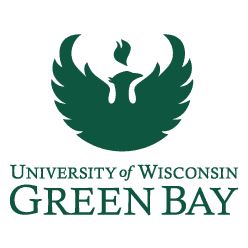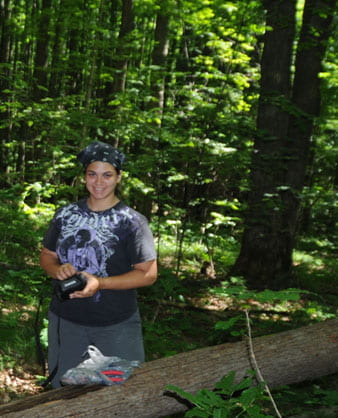
Eleven University of Wisconsin-Green Bay students have been selected to receive Cofrin or Land Trust student research grants for the 2013-2014 academic year. These grants provide unique opportunities for students to pursue faculty-guided research that contributes to the conservation and management of natural areas in Northeastern Wisconsin.
The Cofrin grants are available for students conducting research on UW-Green Bay managed natural areas, including the Cofrin Memorial Arboretum, Kingfisher Farm, Peninsula Center Sanctuary, Point au Sable Nature Preserve, Toft Point Natural Area and the Wabikon Forest Dynamics Plot. These grants are made possible through a generous endowment from the family of Dr. David A. Cofrin and the late John Cofrin. The Land Trust Grant is funded by a donation by UW-Green Bay faculty members Michael Draney and Vicki Medland to encourage students to conduct research that contributes to areas managed by recognized land trusts, nonprofit organizations or state or federal agencies.
More information about the Cofrin Grants and UW-Green Bay natural areas is available at www.uwgb.edu/biodiversity. Photos and student updates will be available on the Cofrin Center for Biodiversity Facebook page, www.facebook.com/Cofrinbiodiversity.
Award recipients are as follows:
Land Trust Grant
Tim Flood, Kenosha — An Environmental Science and Policy graduate student, Flood will examine the colonization of plant communities at the Cat Island Chain Restoration Project now under construction in the lower Bay of Green Bay. The island chain is expected to create protected habitats that should support high quality aquatic plants and provide habitat and forage for water birds, fish and other aquatic organisms. The project will provide insight into the current and expected success of the Cat Island Chain Restoration project. Flood will work under the guidance of adjunct faculty member Patrick Robinson.
Cofrin Grants
Amanda Johnson, McFarland — The importance of woodchucks as “ecological engineers” has been suggested for many years, but little documentation is available to support this claim. The UW-Green Bay campus and its Cofrin Arboretum are home to a healthy population of woodchucks, and Johnson, a senior, hopes to learn more about the importance of woodchucks and their burrows to other animals (including red fox, eastern cottontails and other mammals). Under the supervision of Prof. Robert Howe, she will mark and watch burrows with heat-sensitive cameras to capture activity by visitors and residents of old and new woodchuck burrows. The study will provide insights into the importance of woodchuck burrows for maintaining local mammal diversity in semi-natural landscapes like that of the Cofrin Arboretum.
Sravani Karnam, Nairobi, Kenya — Karnam was inspired to study aquatic systems after a presentation by Natural and Applied Sciences seminar speaker Carrie Kissman, an assistant professor of Biology at St. Norbert College who conducts research on trophic cascades in freshwater lakes. Karnam developed a proposal to model trophic dynamics in pond habitats on the Cofrin Arboretum. The primary objective of her study is to understand the trophic organization in the ponds by evaluating the density and composition of phytoplankton and zooplankton at different times of the year. She will use the results to create models of trophic interactions that predict the nutrient conditions and roles of higher-level predators in these systems. Karnam will work under the supervision of Associate Profs. Amy Wolf and Atife Caglar, with assistance from Kissman and Medland.
Jessica Kempke, Green Bay — Graduate student Kempke will be conducting a study of bat migration patterns along the Lake Michigan coast in northeastern Wisconsin using ultrasound recorders or “bat detectors.” These devices record the high-frequency calls of bats, which can be identified in many cases to species. Kempke will compare bat diversity and abundance along the coastline with paired sites 3-5 kilometers inland. Her study will contribute to the knowledge of the distribution of bat species as well as trends in migration and habitat use. Kempke’s project is a collaborative effort with U.S. Fish and Wildlife Service biologists and is part of her graduate research at UW-Green Bay, under the supervision of faculty members Wolf and Howe.
Brianna Kupsky, Green Bay — A UW-Green Bay senior, Kupsky also will conduct research on bats, collecting data at several UW-Green Bay natural areas. This research is a continuation of a study she began last year with the help of a Cofrin Research grant. The purpose of Kupsky’s project will be to develop and implement a systematic monitoring program of migratory and resident bat populations at the UW-Green Bay managed natural areas. This information will continue to create a baseline for future studies and will help verify the composition of resident and migratory bat assemblages at these areas. Kupsky is working under the guidance of Prof. Howe.
Christa Meyer, Medford — Meyer, a senior, already has collected detailed information about a family of red foxes living in the Cofrin Arboretum. Her proposal aims to document the behavior of the adult foxes and their pups during the course of the summer. She also hopes to document the interspecific interactions between the foxes and other animals that occur in the Cofrin Arboretum and UW-Green Bay campus. Christa is working with Howe as an outgrowth of an independent study project during spring 2013.
Amanda Nothem, Campbellsport — Education major Nothem, under the guidance of Associate Prof. Scott Ashmann, will create hands-on K-12 curricula for teacher-guided field trips to UW-Green Bay’s Cofrin Arboretum. The curricula, aimed at educators at different grade levels, will include pre- and post-assessments, handouts, data collection sheets, data analysis sheets and reflection/discussion questions for water and atmospheric testing in the Cofrin Arboretum. Equipment purchased with the grant will be available for teachers to check out from the Education Department.
Tom Prestby, Wauwatosa — Graduate student Prestby will be surveying migratory shorebirds in the coastal zone of lower Green Bay, Lake Michigan. His study will document shorebirds and provide maps of potential shorebird stopover habitat in the lower Green Bay coastal zone. Under the guidance of Howe and Wolf, he will use field data to estimate the extent and variability of habitat for migrating shorebirds in lower Green Bay.
Mary Quade, Green Bay — Mosses are the second most abundant group of land plants on Earth. Senior Mary Quade will be documenting moss abundance and biodiversity at the Wabikon Lake Forest Plot under the guidance of Associate Prof. Wolf. She will document moss community associations and the size and species of trees used by different moss species. Quade’s results will be important for longitudinal studies looking at the effect of climate change on diversity and abundance of mosses, as well as the potential role of mosses as indicators of environmental quality.
Haley Sharpe, Green Bay — An undergraduate, Sharpe will look at the dispersal of tree fungi by woodpeckers. Her project proposes to collect fungal swabs from the beaks of woodpeckers that are captured and banded at the Point au Sable Nature Preserve. Samples from the birds will be grown in the lab and tree fungi identified. This study will help determine the importance of woodpeckers as vectors of fungi between dead and decaying trees. Sharpe will be working under the guidance of faculty members Howe and Wolf.
Linda Vang, Green Bay — Myrmecochory is seed dispersal by ants, and the plants that rely on dispersal by these insects often produce seeds that have an attractive, nutritious structure called an elaiosome. Ants collect the seeds and feed the elaiosomes to their larvae, then discard the seeds outside of their nests. Vang, working with Wolf, will conduct an experimental study to determine the importance of ants in dispersing seeds of wildflowers in the Cofrin Arboretum. Vang, a senior, will identify which ant species disperse seeds and how quickly the seeds are discovered and removed by ants.



















